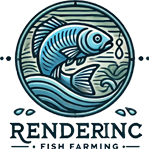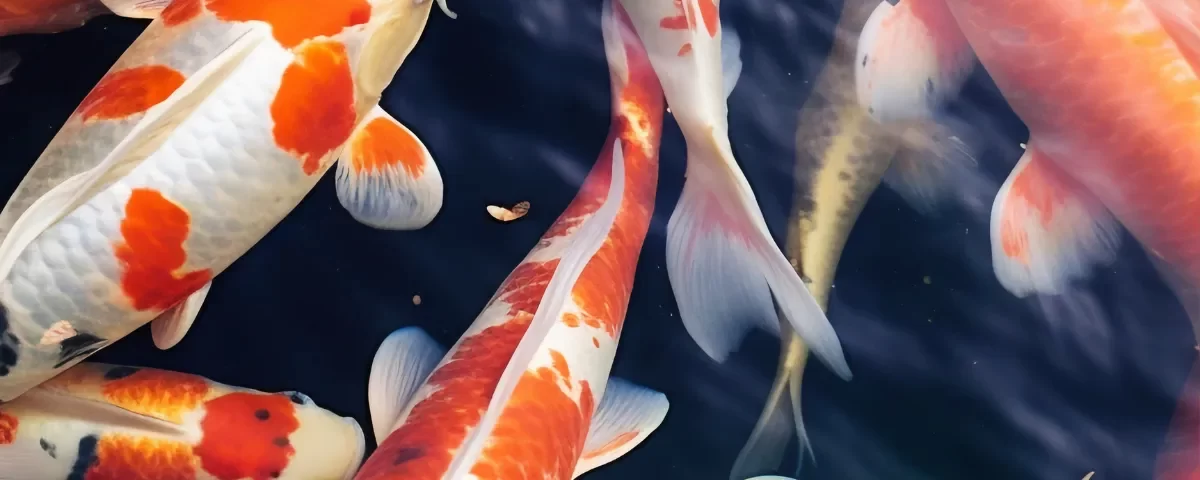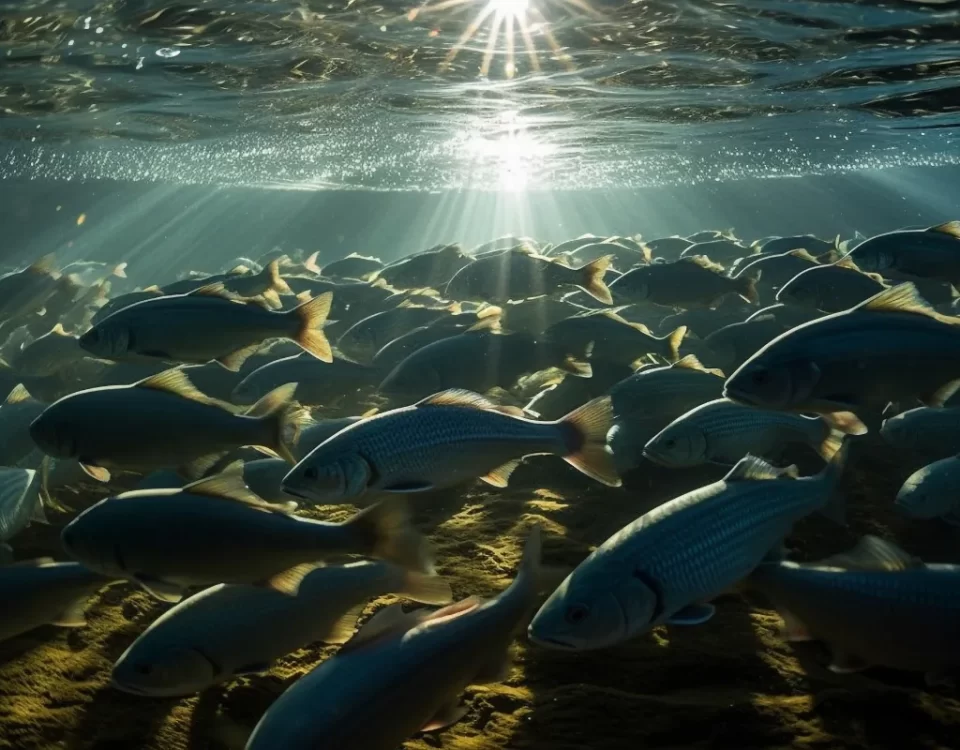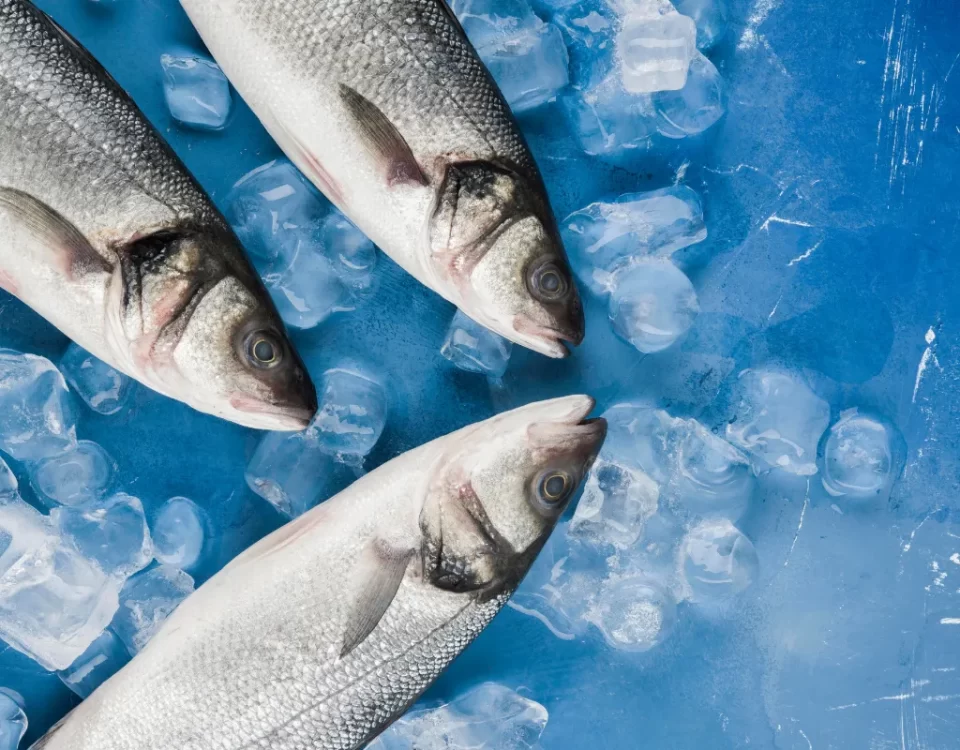Top 10 Fish Species for Commercial Fish Farming

How Blockchain is Enhancing Transparency in the Aquaculture Industry
agosto 30, 2024
Essential Equipment for Effective Aquaculture Systems
setembro 2, 2024The practice of commercial fish farming plays an integral role in meeting the ever-increasing global demand for fish products. As traditional fishing methods struggle to keep pace with this demand, aquaculture emerges as a sustainable solution to ensure a consistent seafood supply. Commercial fish farming involves the controlled breeding of fish in enclosed systems, providing a controlled environment for optimal growth and efficient production.
In recent years, the demand for fish products has skyrocketed due to various factors such as population growth, changing dietary preferences, and the rising awareness of the health benefits associated with consuming fish. This growing demand poses a challenge for the fishing industry to meet the needs sustainably. As a result, commercial fish farming has gained traction as a viable method to supplement wild-caught fish and alleviate pressure on natural fisheries.
To thrive in the commercial fish farming industry, selecting the right fish species is crucial. Different fish species have varying requirements in terms of water quality, temperature, feed, and breeding conditions. In this article, we will explore the top 10 fish species that are well-suited for commercial fish farming operations. These species have proven to be economically viable, environmentally sustainable, and in high demand in the global market.
Tilapia
Tilapia, a pioneering fish in the realm of commercial fish farming, has carved a significant niche for itself in the industry. Known for its rapid growth and hardy nature, tilapia has become a popular choice among fish farmers worldwide. Its mild taste and versatility in cooking have also endeared it to consumers, further fueling its demand in the market.
Overview of Tilapia
Tilapia belong to the cichlid fish family and are native to the freshwater habitats of the Middle East and Africa. However, they have been successfully introduced to various regions around the globe due to their adaptability. This adaptability is a key factor that makes tilapia a preferred choice for aquaculture operations.
Ease of Raising Tilapia
One of the primary reasons for tilapia’s popularity in commercial fish farming is its ease of cultivation. These fish are known for their high tolerance to varying water conditions and can thrive in different environments, be it freshwater ponds, tanks, or cages. Their resilience to fluctuations in temperature and water quality makes them a low-maintenance option for fish farmers.
High Demand in the Market
The high demand for tilapia in the market is another driving force behind its prominence in commercial fish farming. With its lean white flesh and mild flavor, tilapia has secured a place on tables worldwide. The affordability and availability of tilapia further contribute to its popularity among consumers and make it a lucrative choice for fish farmers looking to cater to a growing market.
By choosing tilapia for commercial fish farming, farmers not only align themselves with a profitable venture but also contribute to satisfying the global appetite for this versatile and sustainable fish species.
Catfish
When it comes to commercial fish farming, catfish stands out as one of the most popular and lucrative species in the aquaculture industry. Catfish farming has gained immense popularity due to the robust nature of these fish, their rapid growth rates, and their ability to adapt to various environmental conditions. Catfish are known for their hardiness and resilience, making them a preferred choice for many fish farmers.
Characteristics of Catfish for Farming
Catfish possess several characteristics that make them highly suitable for farming. One key trait is their omnivorous nature, allowing them to thrive on a variety of feed sources, including commercial feeds, plant matter, insects, and even waste products. This versatility in diet makes catfish relatively easy and cost-effective to raise compared to some other finfish species. Additionally, catfish are known for their efficient conversion of feed into flesh, leading to rapid growth and high yields in a relatively short period.
Nutritional Value and Market Demand
Apart from their farming suitability, catfish are prized for their excellent nutritional value. They are a rich source of protein, healthy fats, and essential nutrients such as omega-3 fatty acids. The mild, sweet flavor of catfish meat makes it appealing to a wide range of consumers, contributing to its high market demand. In recent years, the demand for catfish products has been steadily increasing, both in domestic markets and internationally, creating lucrative opportunities for fish farmers looking to capitalize on this trend.
Sustainability and Environmental Impact
In addition to their economic benefits, catfish farming is often praised for its sustainability and relatively low environmental impact. Catfish are typically grown in recirculating aquaculture systems (RAS) or ponds, which can help conserve water resources and minimize pollution. By adopting best practices in aquaculture management, farmers can ensure the long-term viability of their catfish operations while minimizing negative impacts on the environment.
Salmon
Salmon farming plays a pivotal role in the seafood industry, supplying a significant portion of the world’s consumption of this prized fish. With the increasing demand for salmon products globally, the aquaculture industry has embraced the farming of salmon as a viable and sustainable solution to meet consumer needs while alleviating pressure on wild fish populations. Salmon farming involves raising these fish in enclosed environments such as sea cages or freshwater tanks, allowing for controlled growth and production.
Importance of Salmon Farming
Salmon farming presents a host of benefits that contribute to its popularity in the commercial fish farming sector. By cultivating salmon in fish farms, farmers can regulate the feeding and living conditions of the fish, leading to consistent growth rates and quality products. Additionally, farming salmon reduces the reliance on wild-caught salmon, thereby promoting environmental conservation and biodiversity in oceans and rivers. The ability to produce salmon year-round ensures a stable supply for consumers, further solidifying the significance of salmon farming in meeting market demands.
Challenges of Raising Salmon
While salmon farming offers numerous advantages, it is not without its challenges. One notable issue faced by salmon farmers is the potential for disease outbreaks among densely stocked fish populations. Controlling diseases in fish farms requires vigilant monitoring, proper sanitation practices, and timely intervention to prevent widespread infections. Furthermore, the quality of water in which salmon are raised plays a crucial role in their health and growth, necessitating the implementation of effective filtration systems and water management strategies to maintain optimal conditions.
Market Value of Salmon Products
Salmon products command a premium price in the market due to their exceptional taste, nutritional benefits, and versatility in culinary applications. The high demand for salmon, coupled with limited availability from wild sources, contributes to the elevated market value of farmed salmon products. From fresh fillets to smoked salmon delicacies, consumers are willing to pay a premium for the superior quality and consistency offered by farmed salmon. This lucrative market position makes salmon an attractive choice for commercial fish farming enterprises looking to capitalize on the lucrative seafood market.
Trout
Trout is a highly sought-after fish species in commercial fish farming for its delectable taste and versatility in culinary preparations. Trout farming has gained popularity among fish farmers due to its rapid growth rate and ability to thrive in various aquatic environments. The appeal of trout lies not only in its delicious flavor but also in its nutritional value, making it a favorite among health-conscious consumers and culinary experts alike.
Ideal Water Conditions and Feed Requirements
Trout thrives in clean, well-oxygenated waters, with temperatures ranging between 50 to 60 degrees Fahrenheit. These cool-water fish require environments with ample space for swimming and adequate water flow to simulate their natural habitat. When it comes to feed requirements, trout are carnivorous and thrive on a diet high in protein. Commercial trout feed formulations are available that cater to their dietary needs, ensuring optimal growth and development.
Health Benefits and Market Demand
Consuming trout offers a plethora of health benefits, as it is rich in omega-3 fatty acids, protein, and essential vitamins and minerals. Regular consumption of trout can support heart health, brain function, and overall well-being. The growing awareness of the nutritional benefits associated with trout consumption has led to an increase in demand for fresh, high-quality trout in the market. Fish farmers are capitalizing on this trend by focusing on sustainable trout farming practices to meet the rising consumer interest in this prized fish.
Sustainability and Profitability
Trout farming can be a profitable venture for fish farmers who prioritize sustainability and quality. By providing the ideal water conditions, nutritionally balanced feed, and proper care, farmers can ensure the well-being of their trout stock and produce superior-quality fish for the market. Sustainable trout farming practices not only benefit the environment but also contribute to the long-term profitability of the business. With increasing consumer demand for fresh and healthy seafood options, trout farming presents a lucrative opportunity for fish farmers looking to diversify their operations.
Carp
Carp, a ubiquitous fish species in aquaculture, boasts a rich and storied history in the realm of commercial fish farming. Dating back centuries, carp farming has been practiced worldwide, with the fish being revered for its hardiness, adaptability, and rapid growth rate. The cultivation of carp is entrenched in tradition and has evolved into a sophisticated industry that caters to the diverse demands of the modern market.
Carp Farming: A Time-Honored Tradition
The practice of carp farming has deep roots, with civilizations such as the ancient Chinese and Romans recognizing the value of cultivating these resilient fish. Carp are known for their tolerance to various water conditions, making them well-suited for intensive aquaculture systems. Through meticulous breeding and management practices, carp farming has been fine-tuned to optimize growth rates and product quality.
Carp Species for Commercial Fish Farming
Among the plethora of carp species suitable for commercial fish farming, the Common Carp (Cyprinus carpio) and Grass Carp (Ctenopharyngodon idella) stand out as popular choices. The Common Carp, known for its robust nature and fast growth, is prized for its firm and flavorful flesh, making it a staple in many cuisines worldwide. On the other hand, the Grass Carp, recognized for its voracious appetite for aquatic vegetation, serves a crucial role in natural resource management in aquaculture systems.
Versatility of Carp Products
The market for carp products is vibrant and diverse, catering to a range of consumer preferences. Carp meat is esteemed for its taste and nutritional benefits, finding its way into various culinary dishes, from smoked carp delicacies to hearty stews. Additionally, carp products extend beyond the dining table, with carp caviar and fish oil gaining popularity for their health-promoting properties. The versatility of carp in the market underscores its significance in the realm of commercial fish farming.
Shrimp
Shrimp farming, also known as shrimp aquaculture, has become increasingly popular in the aquaculture industry due to the high demand for shrimp products worldwide. Shrimp are known for their delicious taste and are a sought-after seafood delicacy in many cultures. With the advancements in aquaculture technology and practices, shrimp farming has witnessed significant growth to meet the growing market demands.
Challenges in Shrimp Farming
Raising shrimp in farms comes with its set of challenges, including diseases, water quality management, and environmental concerns. One of the major issues faced by shrimp farmers is disease outbreaks, such as bacterial and viral infections, which can significantly impact shrimp production. Water quality management is crucial in shrimp farms to ensure the optimal growth and health of the shrimp. Maintaining the right balance of oxygen levels, pH, and salinity in the water is essential for successful shrimp farming.
Solutions for Shrimp Farming Challenges
To address the challenges in shrimp farming, farmers employ various strategies and solutions. Biosecurity measures, such as routine health checks, quarantine procedures, and proper water treatment, are essential in preventing disease outbreaks in shrimp farms. Selective breeding of shrimp for disease resistance and fast growth is another approach to improving the overall health and productivity of shrimp farms. Additionally, implementing sustainable practices in shrimp farming, such as organic feeds and ecosystem-friendly pond management, can help mitigate environmental concerns.
Global Demand for Shrimp Products
Shrimp products are highly sought after in the global market, with consumers worldwide enjoying shrimp in various forms, including fresh, frozen, and processed products. The increasing demand for shrimp has led to the expansion of shrimp farming operations in many countries, especially in South-East Asia, Latin America, and the United States. With the rise in popularity of shrimp-based dishes and cuisines, the global demand for high-quality shrimp products continues to grow, making shrimp farming a lucrative venture for aquaculture businesses.
Sea bass
Sea bass, a highly sought-after fish species in the culinary world, presents a promising opportunity for commercial fish farming due to its premium market value and delectable taste. Cultivating sea bass offers significant market potential, especially in regions where high-quality seafood is in demand. The popularity of sea bass in gourmet restaurants and seafood markets further underscores its economic viability for fish farmers.
Overview of Sea Bass Farming and Market Potential
Sea bass farming has gained traction in recent years as the supply from wild fisheries struggles to meet the growing demand. By cultivating sea bass in controlled environments such as aquaculture facilities, farmers can ensure a consistent supply of this prized fish throughout the year. The market potential for farmed sea bass is substantial, with consumers willing to pay a premium for fresh, sustainably raised fish.
Feeding Habits and Water Conditions for Raising Sea Bass
Sea bass are carnivorous fish that require a diet high in protein, making them well-suited for commercial fish feeds designed to promote optimal growth. When farming sea bass, it is essential to provide a balanced feed that meets their nutritional requirements and promotes healthy development. Additionally, sea bass thrive in clean, well-oxygenated water with moderate salinity levels, making proper water quality management crucial for successful farming operations.
Culinary Appeal and High Market Value of Sea Bass
Known for its delicate flavor and firm, white flesh, sea bass is highly prized by chefs and seafood enthusiasts for its versatility in various culinary creations. Whether grilled, baked, or pan-seared, sea bass retains its rich flavor and melt-in-your-mouth texture, making it a top choice for gourmet dishes. The high market value of sea bass further enhances its appeal to fish farmers seeking to capitalize on the premium seafood market and cater to the discerning tastes of consumers.
Mackerel
Mackerel, a popular and commercially valuable fish species, holds great promise for fish farmers seeking to diversify their aquaculture operations. With its rapid growth rate and high reproductive capacity, mackerel farming presents a lucrative opportunity for those looking to enter the commercial fish farming industry.
Benefits of Mackerel Farming
One of the primary benefits of mackerel farming is the strong market demand for this flavorful and nutritious fish. Mackerel is a prized seafood item known for its rich taste and high levels of omega-3 fatty acids, making it a favorite among health-conscious consumers. By cultivating mackerel in controlled environments, fish farmers can ensure a sustainable supply of this sought-after species.
Feeding Habits and Environmental Requirements
Mackerel are carnivorous fish that prey on smaller fish and marine invertebrates in the wild. When farming mackerel, it is essential to provide them with a diet rich in protein to support their growth and development. Additionally, mackerel thrive in well-oxygenated waters with temperatures ranging from 50°F to 57°F, making them well-suited for farming in cooler coastal regions.
Nutritional Benefits and Market Demand
Mackerel is not only delicious but also boasts an impressive array of nutritional benefits. This fish is an excellent source of protein, vitamins, and minerals, making it a valuable addition to a balanced diet. As consumer awareness of the health benefits of mackerel continues to grow, the demand for this fish in the market is on the rise, creating a favorable economic outlook for mackerel farmers.
Barramundi
Barramundi, also known as Asian seabass, is a highly sought-after fish species for commercial fish farming due to its rapid growth rate and delicious flavor. Originating from the Indo-Pacific region, barramundi has gained popularity in aquaculture settings globally for its adaptability to various farming conditions.
Farming of Barramundi
Barramundi farming has garnered attention for its high growth potential and low feed conversion ratios, making it an economically viable choice for commercial fish farming operations. These fish can thrive in both freshwater and brackish water environments, providing farmers with flexibility in choosing suitable farming conditions.
Growth Rate and Feed Requirements
One of the key advantages of barramundi farming is its impressive growth rate. Under optimal conditions, barramundi can reach market size within a relatively short period, typically around 12-18 months. These fish are known for their efficient feed conversion, requiring less feed compared to many other fish species, which contributes to lower production costs for farmers.
Market Value
The high market value of barramundi products further solidifies its appeal for commercial fish farming ventures. Barramundi is highly regarded for its tender, white flesh and versatile culinary applications, making it a favorite among chefs and consumers alike. The growing demand for sustainably produced, high-quality seafood presents significant opportunities for barramundi farmers to capitalize on the market demand.
As we conclude our exploration of the top 10 fish species for commercial fish farming, it becomes evident that the world of aquaculture is brimming with diverse opportunities. From the tantalizing taste of salmon to the resilience of tilapia, each fish species offers its unique benefits and challenges for prospective fish farmers.
Sustainable and responsible fish farming practices are imperative as we look towards the future of our oceans and the global food supply. By prioritizing environmental stewardship, fish farmers can ensure the long-term viability of their operations while contributing to the conservation of marine ecosystems.
I urge aspiring fish farmers to explore the myriad opportunities within the aquaculture industry. Whether you are a seasoned entrepreneur or a budding enthusiast, the world of fish farming offers endless possibilities for growth, innovation, and impact. By embracing technology and best practices, you can carve out a successful and sustainable path in this dynamic field.
So, dear readers, let us embark on this aquatic adventure together, as we dive into the depths of commercial fish farming and discover the boundless potential that lies beneath the tranquil surface of our waters.

Michael Rivers is an experienced aquaculture enthusiast with over a decade of hands-on knowledge in fish farming and sustainable aquatic systems. Passionate about promoting eco-friendly practices, he shares his expertise on fish breeding, water management, and the latest advancements in aquaculture technology. Through his blog, Michael aims to help both beginners and seasoned fish farmers achieve success in their ventures while contributing to the growth of sustainable food production.




